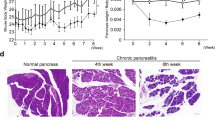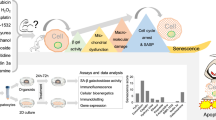Abstract
After partial hepatectomy (PH), the recovery of liver mass is mainly mediated by proliferation and enlargement of hepatocytes. Therefore, measuring the transcriptional profiling of hepatocytes after PH will be helpful in exploring the mechanism of liver regeneration (LR). Firstly, hepatocytes were isolated from rat regenerating liver at different time points following PH, and then global gene expression analysis of hepatocytes was performed using Rat Genome 230 2.0 Array. The results demonstrated that 1,417 genes in the array (including 767 known genes) were identified to be LR-related. Clustering analysis demonstrated that 767 known genes fell into six classes with distinct expression kinetics. When gene expression patterns were combined with gene functions, genes involved in acute-phase response and defense response were rapidly elevated in early phases; those in cell proliferation and DNA replication were significantly up-expressed in middle phase; a growing number of cell adhesion-involved genes were up-regulated as regeneration progressed; those in amino acid and lipid metabolism showed persistent down-regulation during LR. Based on the above analyses, it was suggested that hepatocyte defense mechanism was quickly triggered after PH; cell proliferation became active in middle phase; cell adhesion was strengthened in late phase; amino acid and lipid metabolism were attenuated during LR. Additionally, comparative analysis between transcriptional profiling of hepatocytes and regenerating liver indicated a major contribution of hepatocytes to LR.




Similar content being viewed by others
Abbreviations
- LR:
-
Liver regeneration
- PH:
-
Partial hepatectomy
- H-clustering:
-
Hierarchical clustering
- SO:
-
Sham operation
- RL:
-
Regenerating liver
- GO:
-
Gene ontology
References
Bhalla US, Iyengar R (1999) Emergent properties of networks of biological signaling pathways. Science 283:339–340
Birkhahn RH, Awad S, Thomford NR (1994) Parenteral monoacetoacetin and liver regeneration interaction after partial hepatectomy in the rat. JPEN J Parenter Enteral Nutr 18:219–224
Botchan M (1996) Coordinating DNA replication with cell division: current status of the licensing concept. Proc Natl Acad Sci USA 93:9997–10000
Chung H, Kim HJ, Jang KS et al (2006) Comprehensive analysis of differential gene expression profiles on diclofenac-induced acute mouse liver injury and recovery. Toxicol Lett 166:77–87
Collins JF (2006) Gene chip analyses reveal differential genetic responses to iron deficiency in rat duodenum and jejunum. Biol Res 39:25–37
De Rossi A, Rocha LB, Rossi MA (2007) Application of fluorescence microscopy on hematoxylin and eosin-stained sections of healthy and diseased teeth and supporting structures. J Oral Pathol Med 36:377–381
Desbois-Mouthon C, Wendum D, Cadoret A et al (2006) Hepatocyte proliferation during liver regeneration is impaired in mice with liver-specific IGF-1R knockout. FASEB J 20:773–775
Diehl AM, Rai RM (1996) Liver regeneration 3: regulation of signal transduction during liver regeneration. FASEB J 10:215–227
Dransfeld O, Gehrmann T, Köhrer K, Kircheis G, Holneicher C, Häussinger D, Wettstein M (2005) Oligonucleotide microarray analysis of differential transporter regulation in the regenerating rat liver. Liver Int 25:1243–1258
Estes MD, Do J, Ahn CH (2009) On chip cell separator using magnetic bead-based enrichment and depletion of various surface markers. Biomed Microdevices 11:509–515
Fallon MB, Nathanson MH, Mennone A, Sáez JC, Burgstahler AD, Anderson JM (1995) Altered expression and function of hepatocyte gap junctions after common bile duct ligation in the rat. Am J Physiol 268:C1186–C1194
Fausto N (2000) Liver regeneration. J Hepatol 607:19–31
Fladmark KE, Gjertsen BT, Molven A, Mellgren G, Vintermyr OK, Døskeland SO (1997) Gap junctions and growth control in liver regeneration and in isolated rat hepatocytes. Hepatology 25:847–855
Fukuhara Y, Hirasawa A, Li XK et al (2003) Gene expression profile in the regenerating rat liver after partial hepatectomy. J Hepatol 38:784–792
Guo F, Nian H, Zhang H, Huang L, Tang Y, Xiao X, He D (2006) Proteomic analysis of the transition from quiescent to proliferating stages in rat liver hepatectomy model. Proteomics 6:3075–3086
Hamel F, Grondin M, Denizeau F, Averill-Bates DA, Sarhan F (2006) Wheat extracts as an efficient cryoprotective agent for primary cultures of rat hepatocytes. Biotechnol Bioeng 95:661–670
Higgins GM, Anderson RM (1931) Experimental pathology of the liver: restoration of the liver of the white rat following partial surgical removal. Arch Pathol 12:186–202
Jaeschke H (2006) Mechanisms of liver injury. II. Mechanisms of neutrophil-induced liver cell injury during hepatic ischemia-reperfusion and other acute inflammatory conditions. Am J Physiol Gastrointest Liver Physiol 290:G1083–G1088
Khan AZ, Mudan SS (2007) Liver regeneration: mechanisms, mysteries and more. ANZ J Surg 77:9–14
Kibler K, Svetz J, Nguyen TL, Shaw C, Shaulsky G (2003) A cell-adhesion pathway regulates intercellular communication during Dictyostelium development. Dev Biol 264:506–521
Landemore G, Debout C, Quillec M, Izard J (1984) Isolation of Kurloff cells by Percoll density gradient centrifugation: protein labeling with 35S-methionine of these cells. Biol Cell 50:121–126
Li H, Chen X, Zhang F, Ma J, Xu C (2007) Expression patterns of the cell junction-associated genes during rat liver regeneration. J Genet Genomics 34:892–908
Locker J, Tian J, Carver R, Concas D, Cossu C, Ledda-Columbano GM, Columbano A (2003) A common set of immediate–early response genes in liver regeneration and hyperplasia. Hepatology 38:314–325
Michalopoulos GK, DeFrances M (2005) Liver regeneration. Adv Biochem Engin/Biotechnol 93:101–134
Michalopoulos GK, Khan Z (2005) Liver regeneration, growth factors, and amphiregulin. Gastroenterology 128:503–506
Milo R, Shen-Orr S, Itzkovitz S, Kashtan N, Chklovskii D, Alon U (2002) Network motifs: simple building blocks of complex networks. Science 298:824–827
Palmes D, Spiegel HU (2004) Animal models of liver regeneration. Biomaterials 25:1601–1611
Post GR, Brown JH (1996) G protein-coupled receptors and signaling pathways regulating growth responses. FASEB J 10:741–749
Revel JP, Yancey SB, Meyer DJ, Nicholson B (1980) Cell junctions and intercellular communication. In Vitro 16:1010–1017
Stoick-Cooper CL, Moon RT, Weidinger G (2007) Advances in signaling in vertebrate regeneration as a prelude to regenerative medicine. Genes Dev 21:1292–1315
Togo S, Makino H, Kobayashi T et al (2004) Mechanism of liver regeneration after partial hepatectomy using mouse cDNA microarray. J Hepato 40:464–471
Vondran FW, Katenz E, Schwartlander R et al (2008) Isolation of primary human hepatocytes after partial hepatectomy: criteria for identification of the most promising liver specimen. Artif Organs 32:205–213
Wang GP, Xu CS (2010) Reference gene selection for real-time RT-PCR in eight kinds of rat regenerating hepatic cells. Mol Biotechnol 46:49-57
Wang WB, Fan JM, Zhang XL, Xu J, Yao W (2009) Serial expression analysis of liver regeneration-related genes in rat regenerating liver. Mol Biotechnol 43:221–231
Werner T (2001) Cluster analysis and promoter modeling as bioinformatics tools for the identification of target genes from expression array data. Pharmacogenomics 2:25–36
Xie Y, Wang C, Li L, Ma Y, Yin Y, Xiao Q (2009) Overexpression of E2F-1 inhibits progression of gastric cancer in vitro. Cell Biol Int 33:640–649
Xu CS, Chang CF, Yuan JY et al (2005) Expressed genes in regenerating rat liver after partial hepatectomy. World J Gastroenterol 11:2932–2940
Xu CS, Xing XK, Yang XG et al (2009) Hydrodynamics-based transgene directively into rat regenerating liver in vivo. Acta Anatomica Sinica 40:599–603
Acknowledgment
This work was supported by the National Basic Research 973 Pre-research Program of China (No. 2010CB534905)
Author information
Authors and Affiliations
Corresponding author
Additional information
Communicated by: A. Kispert
Electronic supplementary materials
Below is the link to the electronic supplementary material.
Supplementary Table 1
Gene expression profiling data of both sham-operated groups (highlighted in red) and partial-hepatectomized groups (highlighted in blue) for six clusters. *Gray-colored bins represent greater than or equal to threefold up-regulation; spot-marked bins represent greater than or equal to threefold down-regulation; colorless bins represent the insignificant expression. (XLS 403 kb)
Supplementary Table 2
List of the functionally categorized genes enriched in different induction patterns * a Genes enriched in the pattern characterized by “immediate–early and early induction” (clusters 1 and 4). b Genes in the pattern “middle induction” (cluster 2). c Genes in the pattern “middle and late induction” (cluster 3). d Genes in the pattern “persistent repression” (cluster 6). The gray- and spot-marked bins indicate at least threefold up-regulation and at least threefold down-regulation, respectively; and colorless bins represent the insignificant expression. The data presented in bins are the ratio of the signal value of genes in PH groups versus that in control group. (XLS 99 kb)
ESM 1
(PDF 367 kb)
Rights and permissions
About this article
Cite this article
Xu, C., Chen, X., Chang, C. et al. Transcriptome analysis of hepatocytes after partial hepatectomy in rats. Dev Genes Evol 220, 263–274 (2010). https://doi.org/10.1007/s00427-010-0345-1
Received:
Accepted:
Published:
Issue Date:
DOI: https://doi.org/10.1007/s00427-010-0345-1




